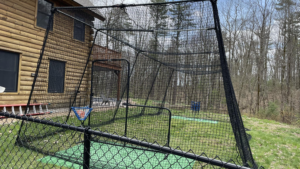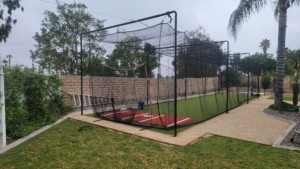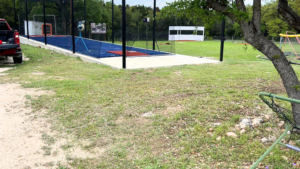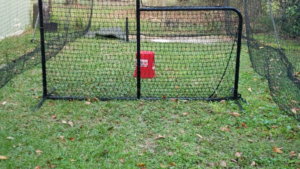5 Types of Backyard Batting Cages (Pros, Cons & Recommendations)
So, when it comes to setting up a backyard batting cage, there’s no one-size-fits-all solution. You should consider several different setups depending on your space, budget, and specific goals. In this guide, we’ll break down 5 popular kinds of backyard batting cages, including pros, cons, and expert recommendations to help you decide.
1. Freestanding Batting Cage

This standalone cage is one of the most flexible options. It’s built with metal or PVC frames and doesn’t require permanent installation.
Pros:
- Can be placed anywhere in your yard
- Easy to install and disassemble
- Budget-friendly
- Portable for moving if needed
Cons:
- May lack long-term durability
- Less stable in high winds
- Smaller size due to space limits
Recommended for: Families with limited space who want something quick and functional. Read this first before installing one.
2. In-Ground Batting Cage

Built permanently into the ground with concrete footings for maximum strength and stability.
Pros:
- Extremely stable and long-lasting
- Can be customized to your space
- Ideal for heavy use and pro-style training
Cons:
- Requires digging and concrete work
- More expensive and permanent
- Can’t easily be moved or changed
Recommended for: Homeowners wanting a premium backyard setup. Consider hiring a pro for installation.
3. Attached Batting Cage

Built off an existing structure like a garage, shed, or barn. Space-saving and often weather-protected.
Pros:
- Maximizes yard space
- Weather-shielded
- Quick access if attached to garage or shop
Cons:
- Structural attachment must be secure
- Limited to dimensions of the existing building
- May require permits
Recommended for: Properties with existing buildings and limited yard space.
4. Retractable Batting Cage

This retractable system can be pulled open when in use and stowed away when not needed, making it ideal for shared-use yards.
Pros:
- Highly space-efficient
- Easy to use
- Often built with heavy-duty materials
Cons:
- More expensive
- May require maintenance on the track or net system
- Usually needs pro install
Recommended for: Multipurpose yards and modern homes that want flexibility without compromise.
5. DIY Batting Cage Kit

Buy a pre-packed kit that includes frame components, netting, and instructions — then build it yourself at home.
Pros:
- Budget-friendly
- Customizable to your yard’s needs
- Gives satisfaction from building it yourself
Cons:
- Requires tools and construction skills
- Quality depends on how well it’s built
- More time-consuming to assemble
Recommended for: Handy homeowners who want to save money and build something custom.
Final Thoughts
No matter which batting cage style you choose, it’s all about what works best for your backyard, goals, and budget. From premium in-ground builds to flexible retractables or fun DIY kits, there’s a perfect option out there for every family or ballplayer.
Want to turn your batting cage into a side income? You can list your cage on CageList and rent it out by the hour. The better the setup, the more you can charge. Make it a win-win for your family and your community.
Need inspiration or tips for building yours? Join the Backyard Batting Cages Facebook group and explore more expert articles on the CageList blog.
